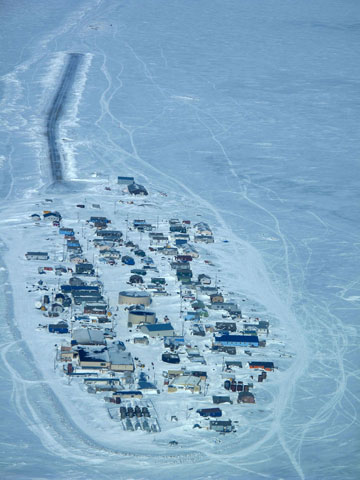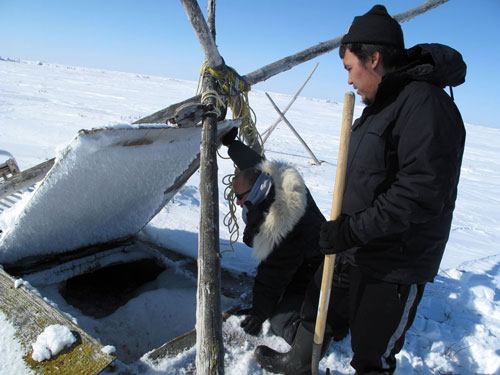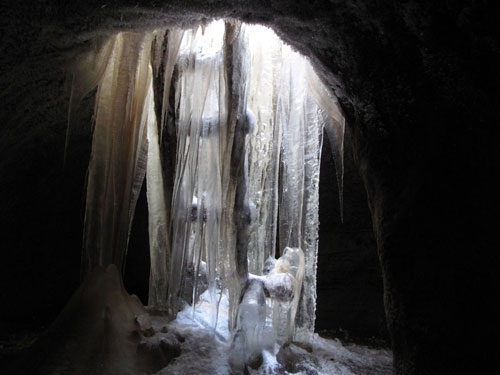
Alaska Science Visiting a far north ice cellar
April 21, 2011
As soon as the Navajo props stop spinning, out jumps Kenji Yoshikawa, there for one of his patented science hit and runs. Yoshikawa is soon kneeling on a long wooden sled towed by Hawley, who heads for a few wooden tripods standing on the white arctic plain outside town. The tripods mark the locations of three ice cellars - “sigluaqs” in Inupiat - chipped into the ground as a means to preserve food. “This is the biggest cellar of the whaling communities,” Yoshikawa says as he and Hawley remove wind-packed snow from a half sheet of plywood that covers the cellar entrance. Yoshikawa, a permafrost scientist at the University of Alaska Fairbanks, has climbed down ladders into ice cellars of every northern Alaska community that has them - Kaktovik, Barrow, Nuiqsut, Wainwright, Point Lay, Point Hope, Gambell, Savoonga, Wales, Kivalina and Little Diomede. People in the northernmost villages dug the chambers into ground that remains frozen all year to preserve chunks of bowhead or beluga whale. Villagers south of Point Hope use the ice cellars more as refrigerators to help them ferment walrus and other favorite foods. After some chipping and digging, Yoshikawa reaches a second square of plywood that seals the entrance to the ice cellar. With help from Hawley, he levers it up and sets it aside, revealing a gorgeous growth of matchbook-size ice crystals underneath. For the first time in months, sunlight strikes a ladder covered with ice that extends 20 feet to the frozen floor of the sigluaq. The ladder is encased in icicles as thick as Yoshikawa’s legs, making some of the rungs impassible. “I’ll go get my ice chisel,” Hawley says. He hops on his snowmachine and drives home.
Kenji Yoshikawa and Kivalina resident Perry Hawley pry the top from an ice cellar.
Inside, he flicks a lighter he borrowed from Hawley to see if there is sufficient oxygen for him to breathe and to see if he can locate a temperature sensor that is about the size of the lighter. With permission from Native elders, he placed the sensor in the cellar one year ago. If he finds it, he will have one year of temperature data from inside the cellar. In the past, this cellar’s temperature ranged from 30 degrees Fahrenheit in summer to 25 degrees Fahrenheit in winter. He has observed about one-half degree warming in most of the cellars he has monitored during the last five years. “That’s a lot,” he says. “Very much affected by (an increasing lack of) sea ice.” The Kivalina cellar is as large as a corner office, with the ladder separating two lobes chipped from the permafrost. The floor is slippery, with ice crystals on a surface of ice providing little friction. Unlike in other ice cellars, there is no pungent smell; Kivalina villagers have not taken a whale in several years. The chambers are empty, except for one thing.
Icicles cling to a ladder in a Kivalina ice cellar.
Using the lighter and the focus beam from his camera, he finds his sensor wedged in a divot he had chipped a year earlier in the frozen wall. He pockets it and installs an identical sensor in its place, first wetting it in his mouth so it sticks. After snapping a few photographs of the ladder entombed in ice, he climbs back to the brilliant daylight of April. His mission accomplished, Yoshikawa replaces the two sheets of plywood to seal the ice cellar. Slowing for the larger drifts, Hawley takes him on a bumpy ride back to the airstrip, where Lorring waits in the Navajo. In a single-day four-village tour that began and will end in Yoshikawa’s home city of Fairbanks, the next stop is Kotzebue. In Yoshikawa’s pocket are temperature sensors from Point Lay, Point Hope and Kivalina. Their data will add to a collection of temperatures of ice cellars in northern coastal villages, helping record changes as the air temperatures above fluctuate. On this late winter day of about 0 degrees Fahrenheit, the food storage chambers of northern Alaska are probably all in good shape. After Hawley motors off, Lorring revs the Navajo’s engines and lifts off into the breeze, casting a shadow on an airstrip that extends like a tadpole’s tale from the village of Kivalina.
This column is provided as a public service by the Geophysical Institute, University of Alaska Fairbanks, in cooperation with the UAF research community.
E-mail your news &
photos to editor@sitnews.us
|
||


